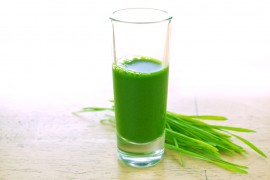Every morning Lara Williams sits down to a breakfast of cottage cheese on rye bread.
A multivitamin tablet chased down with a 150ml glass of pomegranate juice (out of a bottle) completes the first meal of the day.
Lunch is usually a chicken breast with half a cup of brown rice or pasta and a carefully-chosen selection of grilled vegetables.
Dinner is fish with different vegetables (this time steamed or boiled) and a side salad.
Occasionally she rings the changes with a stir-fry of greens and beansprouts on soba noodles. Either way, dessert will be no-fat yogurt with strawberries.
Her daily total will come out at a carefully calculated 1,400 calories. According to mainstream nutritional thinking, a woman of her height should eat at least 2,000.
Lara, who is 43, is around 15% under her ideal weight but she is not anorexic. Nor is she on this regime for the weight loss; that has been a mere side effect.
She is one of a growing group of hard-core health enthusiasts following a “Calorie Restriction with Optimum Nutrition” (CRON) diet.
There is a considerable body of scientific evidence suggesting that reducing calorie intake by 20-50% below the recommended amount, while meeting nutritional needs, is the best thing we can do if rejuvenation and longevity are our goals.
Many things, including stem cell therapy, human growth hormone, nutritional supplements and a variety of drugs, are claimed to be “anti-aging”. But there is no reliable scientific evidence that anything besides calorie restriction is capable of retarding biological aging nor extending maximum lifespan.
So from that point of view Lara and others on similar regimes are definitely onto something. But the “optimum nutrition” part of the equation is more important than the calorie restriction component.
Anorexics, prisoners of war and others who subsist on fewer calories than their bodies require over prolonged periods do not live longer; they perish sooner.
The average CRON diet is certainly streets ahead of the standard diet: empty calories are low to non-existent and junk food doesn’t figure.
But if you want to meet all of your nutritional needs in the fewest calories possible, rule number one is to eat as much raw food as possible.
Why? Because cooking makes 50-70% of protein in food non-bioavailable, it interferes with the body’s absorption of minerals, it denatures essential fats, and destroys 70%-90% of water-soluble vitamins and phytonutrients.
Given these figures, it is hard to understand why those on calorie restricted diets would be switching their ovens on at all.
But browse the many “CRON diet” journals posted online and you’ll discover a strange paradox. Much is made of the importance of “nutrient-dense” calories and meals.
Yet you’ll struggle to find a mention of anything unfired being consumed, let alone a food diary which has raw foods as the foundation of the meals being painstakingly documented.
Take breakfast as an example.
A big green juice loaded with nutrient-packed sprouts, or a bowl of mixed raw berries, or an infinite number of variations on the raw smoothie – any of these would be a much better choice than the combinations of wheat, dairy and pasteurised fruit juice favoured by most CRON enthusiasts.
It’s clear the world of calorie restriction could benefit from learning about raw nutrition, but the reverse is also true.
Many raw fooders experience less than optimal health and energy because they consistently overeat. So what, exactly, is the evidence that restricting calories makes us younger, healthier and longer-lived?
It all began with a 1934 Cornell University research study. Clive McCay and Mary Crowell were researching the effects of calorie restriction on rats, and found that when the animals were fed all the necessary nutrients but the calories in their diets were drastically cut, they lived substantially longer.
Similar results have been observed in all species tested, and that now includes everything from insects to apes. Meeting nutritional needs on 20-50% fewer calories will extend lifespan.
Study after study has shown it is not only the mean lifespan that increases but also the maximum lifespan: i.e., some of the study animals lived longer than previously thought to be possible for the species in question.
Another interesting phenomenon observed by some researchers: calorie-restricted animals who were still bearing offspring even when all the regularly fed animals in the study had grown old and died.
In all species studied, the most astonishing results are obtained if calories restriction begins in infancy; however, if you are a parent, don’t try it on your offspring as it is also shown to stunt growth. Still, life-span increases of up to 20 per cent have been observed in mice that began restricted diets as adults.
Since this science is relatively new, and humans live so long, there are no human studies proving conclusively that calorie restriction will have the same effect on humans.
But the results from many short-term studies are in and they are conclusive: calorie restriction reduces all of the biomarkers for aging and lowers the risk of chronic diseases.
One noteworthy human study is the famous Biosphere II experiment. During the two years between September 1991 and September 1993 eight scientists lived inside this enclosed ecosystem, which allowed no contact whatsoever with the outside world.
The group had to do everything needed for survival, including growing all their own food. One of the eight, the resident physician, was none other than UCLA gerontologist Roy Walford, who had been studying the effects of calorie restriction on longevity, and following such a diet himself.
When it was not possible to grow as much food as anticipated within the Biosphere, Walford convinced his fellow inhabitants to adopt a calorie-restricted diet.
The results were astounding. Blood pressure, blood sugar, cholesterol and triglyceride levels all fell by at least 20 percent to extremely healthy levels.
The team members also exhibited enhanced immunity and an increased capacity to fight off illnesses.
In a human study by John O. Holloszy, a professor of medicine at Washington University in St. Louis, 18 people who had been practicing calorie restriction for three to fifteen years showed dramatically reduced risk of developing diabetes or clogged arteries.
The study subjects, with an average age of 50, had the blood pressure readings of 10-year-olds.
Commenting on the study Holloszy said, “It’s very clear that calorie restriction has a powerful, protective effect against diseases associated with aging. We don’t know how long each individual actually will end up living, but they certainly have a much longer life expectancy than average because they’re most likely not going to die from a heart attack, stroke or diabetes.”
A six-month study of 48 people who reduced calories by 25 per cent or more was published in The Journal of the American Medical Association.
Among the main findings was that calorie restriction led to decreases in insulin levels and body temperature. Both are considered signs of longevity, since an earlier study found both traits in long-lived people.
Another observed benefit was a decline in DNA damage.
How does calorie restriction turn back the clock?
Every aspect of the aging process appears to be slowed by calorie restriction. But to understand why, we have to understand what causes aging.
Since there is still much disagreement about this among the medical community, unsurprisingly a unified consensus about exactly how calorie restriction counteracts it has yet to be reached.
Modern aging theories can be divided into two main categories: wear and tear aging theories and programmed aging theories.
These theories are not mutually exclusive; in fact the latest research suggests that aging is caused by a complex mix of internal and external factors, and that both theories are partially correct.
And the best news is that animal studies suggest that calorie-restricted diets have the potential to offset both kinds of aging.
Programmed aging theories stem from the idea that certain changes associated with aging are programmed by a gene-controlled “biological clock”, the same clock that programmes other life stages such as cell differentiation in the embryo and sexual maturation at adolescence.
In a University of Wisconsin study on rodents, gerontologist Richard Weindruch and geneticist Tomas Prolla found that 70 per cent of the major changes in gene expression associated with aging were totally or partially prevented by calorie restriction.
A University of California professor, Dr Stephen Spindler, spent years studying the effect of calorie restriction on 11,000 age-related genes in animals.
Using microchip technology he proved that the expression of many of these genes was actually reversed, and that gene expression changed rapidly to a pattern associated with lower mortality and better health.
Those findings were reported in 2001 and currently researchers are using the latest analytical methods to determine what’s happening at the genetic levels in human calorie restrictors.
Wear and tear theories are based on the view that aging is caused by damage done to our body cells and systems over time, until eventually we “wear out” completely. Sub-theories include the waste accumulation theory, the faulty reconstruction theory, the mitochondrial damage theory and the molecular cross-linkage theory.
But the most widely accepted wear and tear theory, and the one that encompasses all of the others, is the free radical theory of aging.
According to this theory, aging occurs when free radicals damage the structures of living cells by a process known as oxidation. Free radicals are so reactive they can attach to and damage molecules that usually don’t take part in reactions, including cellular DNA.
The damage continues to accumulate until it eventually manifests itself as some form of degenerative disease. Over 80 degenerative diseases are now known to be linked to free radical-induced oxidative stress and all are manifestations of the same underlying process.
Much of the damage is preventable if we avoid potent free radical generators such as pesticides and herbicides, car exhaust fumes, cigarette smoke, alcohol and various beverages and processed foods.
But normal metabolism causes free radical production, so it is not possible to make your body into a free radical free zone. However, one of the biggest generators of avoidable free radicals is overeating.
While antioxidants have been much touted for their ability to mop up these destructive molecules, calorie-restricted diets do something much better: they ensure there are much fewer of them circulating in the first place.
But a high-raw calorie restricted diet goes a step further.
After all, if you were to eat 400 calories worth of chicken and pasta salad – typical “CRON” fare –you’d have many more free radicals zipping around your body than if you’d consumed 400 calories worth of raw energy salad topped with guacamole.
This in turn will benefit all systems of the body. For example, reduced oxidative damage to the immune system means greater resistance to disease.
Animals on calorie-restricted diets do not show the age-related drop in immune system strength seen in their counterparts on regular diets. Research has also shown that calorie restriction may prevent changes in the brain caused by aging, for the same reason.
A final fascinating effect of calorie restriction is on the bodily process of autophagy, which literally means “self-eating”.
One way in which the body copes with the waste by-products of cellular life, such as oxidized fats and cross-linked proteins, is by breaking them down and then recycling them.
But as the body ages, this process can become less efficient, leading to cells becoming overloaded with garbage.
This can interfere with the proper functioning of the cells and is thought to become a vicious cycle: slower autophagy = more rapid accumulation of junk = further damage to the functioning of the cell, including autophagy itself = even slower autophagy – and so on. This has been termed the waste accumulation, or garbage catastrophe, theory of aging.
It has been found that the toxic build-up that results when autophagy can’t keep up with garbage disposal is especially pronounced in those with Alzheimer’s, Parkinson’s and other neurodegenerative disorders.
For example, in Alzheimer’s there is a build-up of plaques in the brain, and obese people are known to be at a higher risk for developing the disease. Restricting the diets of mice has been shown to reduce the build-up of these plaques.
Calorie-restricted diets work to avoid an internal “garbage catastrophe” in two ways: first of all, you are taking in fewer substances which can cause cellular damage which interferes with the normal functioning of the body’s waste disposal system. Secondly, there is simply less garbage to process.
Unsurprisingly, human and animal studies consistently show that the longer the period spent on the diet, the greater the effects. But it is never too late to start.
For example, Dr Spindler and his colleagues showed that calorie restriction acts rapidly, even in old mice, to extend remaining lifespan by 42% and to substantially reduce tumours as a cause of death.
Calorie restriction meets raw nutrition
If you think you’d have to resign yourself to feeling hungry for the rest of your life in order to benefit from this body of scientific knowledge, think again.
The frugal fare of the calorie restricted is not for everyone, but this is not a choice between existing on subsistence rations and laughing all the way into your second century, or eating the standard diet and reaping the standard results. It is a continuum.
To put this in perspective, the average person alive today in the western world eats substantially more calories than they need but is malnourished, because what they eat falls far short of meeting the nutrient intakes required for optimum health.
As word about the effects of calorie restriction spreads, and the scientific evidence mounts, more and more health seekers of all ages are shunning the “all you can eat” mentality and making mealtimes an exercise in mathematics.
But we will have to wait a long time before there is inspiration in the form of large numbers of humans on this programme celebrating their 120th birthdays.
Roy Walford, the UCLA gerontologist and Biosphere II’s calorie restriction pioneer adhered strictly to the lifestyle for several decades and in his book, The Anti-Aging Plan, talked of living to 120-140 as a reasonable expectation for anyone doing the same.
Sadly he died at 79, of complications from Lou Gehrig’s disease. So it is worth remembering that this practice, compelling though the scientific evidence is, comes with no guarantees.
But on balance, Walford stayed healthy and lived longer than most after a diagnosis of this disease, no doubt thanks to his healthy diet.
And perhaps the most important thing to bear in mind is that no studies have yet been done into calorie restriction combined with optimum raw nutrition.
For all its apparent complexity, the reason calorie restriction works can be summed up in very simple terms: it is about giving your body what it needs and very little of anything else.
This means that it has all the nutrients and co-factors necessary to maintain health, and as little as possible of the toxic wastes and by-products that destroy health.
The results achieved in human calorie restriction studies are especially astonishing when you consider that the average subject was consuming a diet very like Lara’s, whom we met at the start of this article.
If such remarkable results are being achieved by those eating little raw food, it’s reasonable to assume those eating more raw could achieve even better results – or the same results on a less rigorous regime.






I wish I could eat less! 🙂 Hard for me to say no to desserts and things like that! Definitely think this diet makes sense though! bBck in the dark ages, there is no way we would have eaten heaps of food!
View CommentThis is the best article I ever read. And I read and tried a lot of different diets. You totally convinced me. I start mostly raw CRON diet. I feel better, more energy, less sleep.
View CommentIt is amazing that I can tell by my needs in sleep, how much calories I ate that day. I lost a few pounds, now I am 101 with 5.5 high, don’t really want to loose more weight, but I hope the weight will stabilize. Thank you very much for such an excellent article.
Hi Natasha,
View CommentThank you for writing in. It’s always great when readers enjoy the articles here and are happy with the results 🙂 But I would be remiss if I didn’t point out that a height of 5 foot 5 with a weight of 101 pounds (if that’s what you meant) gives a Body Mass Index (BMI) of 16.8…and anything below 18.5 is considered underweight. In order to get the best results from the CRON lifestyle it’s important to be a healthy weight. If we are doing the CR (calorie restriction) part of the equation but not the ON (optimum nutrition) one, we won’t get the long-term health benefits. To anyone who is unable to maintain a healthy weight while restricting calories, I’d say favour the optimum nutrition part every time: i.e. eat more, and make it the highest quality food you can.
Wishing you health and happiness!
Sarah x
The CRON people I have read about eat large quantities of raw food (e.g., Joe Cordell, Matthew Lake). Sounds to me like a high raw, low calorie diet is best. Matthew points out that 100% raw may not be best: http://www.crvitality.com/2014/04/raw-food-vs-cooked-food/ Well-designed studies need to be done.
View CommentThank you for the share, Jennifer, and for that link. Agreed – and agreed!
View CommentI only have two things to say:
View Comment1) Excellent article!
2) Dr. Joel Fuhrman. The same results can be achieved simply by following his advice. He has basically perfected the raw food aspect of CRON. 🙂
Thank you, Daniel. And agreed. Fellow Dr Fuhrman fan here 🙂
View Comment